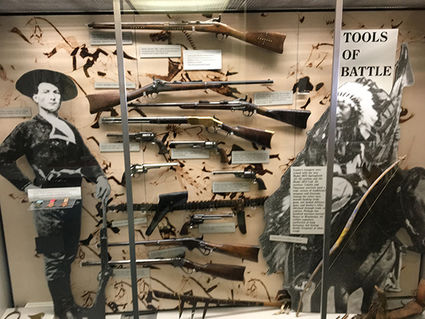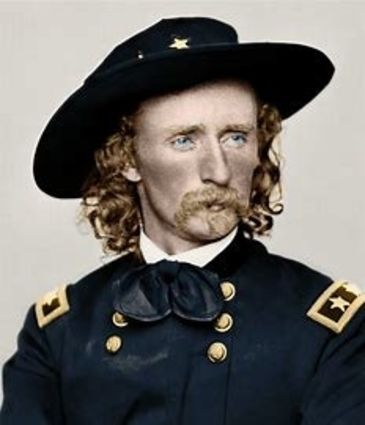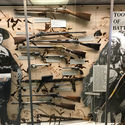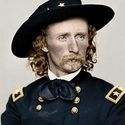Wounded Frank Finkel hangs on as horse bolts
April 2, 2020

-Chronicle photo
This display at the Little Bighorn Interpretive Center shows actual weapons used in the skirmish.
By Gary Lentz
Retired Ranger
Lewis and Clark Trail State Park
Special to the Dayton Chronicle
–Continued from the March 26 installment of Gary Lentz's informative program at the Blue Mountain Heritage Society's fundraiser in February.
Meanwhile, led by Crazy Horse, hundreds of warriors began to surround the remaining three companies up on Last Stand Hill. And as they rode around and as they moved in, the last battle didn't last very long.
The Indians were creating more havoc. They were waving blankets. There was mass confusion on the battlefield. The troopers were no longer being commanded by one or more officers. There was random firing.
The Indians moved in. They got closer. The ones that had bows and arrows fired up into the air and, coming down, the arrows would hit troopers. The ones with guns could hide behind sagebrush and shoot.
Troopers, on the other hand, they had to shoot at every Indian and that left a puff of smoke and that revealed the shooter's position.
But if you were an Indian, you could fire an arrow, and the cavalry troopers didn't really know where the arrows were coming from. They were just trying to survive.
Finkel knew he was doomed, but the horse didn't. It carried him along while the Indians fired at him and continued his headlong dash into who knows where.
We think now that he was headed north. But we're not sure because we have different statements.
Although he didn't know it at the time, there were at least two Indians following him. Knowing he was wounded, they were probably thinking he would be easily disposed of and they could get the horse.
Finkel said he fell off his horse, pulled his Colt .45 service pistol, put it under himself. As one of the Indians approached, he raised up and shot him. The other one took off.
And so did Finkel.
Wounded, lost, thirsty, he tried drinking some foul, alkaline water-and I got to tell you: I went over and scouted this country. Walked around, even rode horses in some of it, and we tasted some of the water in the creeks over there, College Creek and others. They aren't kidding about this. It's really nasty.
He thought he was headed north, but he wasn't sure. He passed out and figured that he was going under.

-Submitted photo
Lt. Col. George Armstrong Custer
Finkel was found by a trapper, he says, who took him back to his cabin and helped him recover. That winter, the trapper's friend passed away, and early the next spring, Finkel headed back towards Fort Benton.
Fort Benton, to him, was the closest military post, and it was somewhere to the northwest of where he had spent the winter. And he figured if he could get up there, he could report in and find out what happened to the rest of his troops.
Remember: Finkel left the battlefield before the battle ended, so he doesn't know exactly what happened to the rest of the men in his company.
Finkel said when he went to the fort and reported in as a trooper from Company C, Seventh U.S. Cavalry. He was told he needed two witnesses, and was also told his company were all killed at the Little Bighorn Battle.
– To be continued










